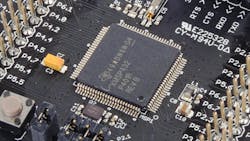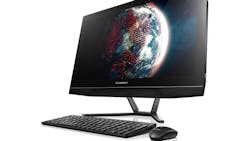Texas Instruments’ (TI) 16-bit MSP430 microcontroller (MCU) family targets ultra-low power applications, including an all-FRAM-based solution (see “FRAM Microcontroller Targets Low Power Applications”). Now the company has expanded the family with a high-end option, the 32-bit MSP432 based on an ARM Cortex-M4F core (Fig. 1).
TI has higher-performance Cortex-M and Cortex-A solutions with faster clock speeds, which get work done more quickly. However, the MSP432 tops out at 48 MHz—that’s two to four times slower than most Cortex-M4F solutions. This allows for an active performance of 95 µA/MHz. Even with the real-time clock (RTC) running, it can sleep at a mere 850 nA.
EEMBC’s ULPBench is literally the benchmark for low-power microcontrollers (see “Interview: Markus Levy Discusses The EEMBC Ultra Low Power Benchmark”). The MSP432’s ULPBench score is 167.4, and its EEMBC CoreMark score is 3.41/MHz. Quite impressive.
The Cortex-M4F brings digital-signal processing and floating-point to the MSP430 family. The nested vector interrupt controller (NVIC) supports tail chaining, and there’s 8-channel direct memory access (DMA). On the analog side, a 14-bit, 1-Msample/s ADC features a differential mode of operation and 13.2 effective number of bits. It also has a pair of window comparators. The digital side includes four eUSCI_A modules that support UARTs, IrDA, and SPI. Another four eUSCI_B modules support I2C and SPI.
The memory subsystem is equally as impressive—the 128-bit flash buffer and pre-fetch system front-ends dual flash banks allow for reliable in-field updates. The system also provides single-cycle operation. Current incarnations are available with 256 kB of flash, with future versions possibly scaling to 2 MB. There is also a 32-kB ROM that contains MSPWare libraries.
The code security lock lets developers provide code for use, but restricts access to runtime operation only. Four blocks can be protected in this fashion. It also uses encrypted authentication to confirm updates. The code in a block can be called, and that code has access to tables within the block. However, other code cannot access any data within a block.
In addition, the chips contain 64kB of RAM with bit-band support. The RAM is divided into 8-kB blocks that can be selectively disabled, even with respect to low-power operation. Each bank uses 30 nA in RAM retention low-power mode.
TI provides a range of tools, including Code Composer Studio and PinMux, the latter handling the MSP432’s pin remapping feature. They are available with the TI Cloud IDE. The company’s MSPWare includes a driver library as well as support for the ROM runtime. A range of third parties, such as Keil and IAR, support MSP432.
The MSP432 LaunchPad (Fig. 2), priced at $12.99, provides access to BoosterPack boards. It works with ULP Advisor and the EnergyTrace+ real-time power debugging tool that help optimize power utilization. EnergyTrace+ tracks power usage and CPU states, as well as application execution.
About the Author
William G. Wong
Senior Content Director - Electronic Design and Microwaves & RF
I am Editor of Electronic Design focusing on embedded, software, and systems. As Senior Content Director, I also manage Microwaves & RF and I work with a great team of editors to provide engineers, programmers, developers and technical managers with interesting and useful articles and videos on a regular basis. Check out our free newsletters to see the latest content.
You can send press releases for new products for possible coverage on the website. I am also interested in receiving contributed articles for publishing on our website. Use our template and send to me along with a signed release form.
Check out my blog, AltEmbedded on Electronic Design, as well as his latest articles on this site that are listed below.
You can visit my social media via these links:
- AltEmbedded on Electronic Design
- Bill Wong on Facebook
- @AltEmbedded on Twitter
- Bill Wong on LinkedIn
I earned a Bachelor of Electrical Engineering at the Georgia Institute of Technology and a Masters in Computer Science from Rutgers University. I still do a bit of programming using everything from C and C++ to Rust and Ada/SPARK. I do a bit of PHP programming for Drupal websites. I have posted a few Drupal modules.
I still get a hand on software and electronic hardware. Some of this can be found on our Kit Close-Up video series. You can also see me on many of our TechXchange Talk videos. I am interested in a range of projects from robotics to artificial intelligence.



